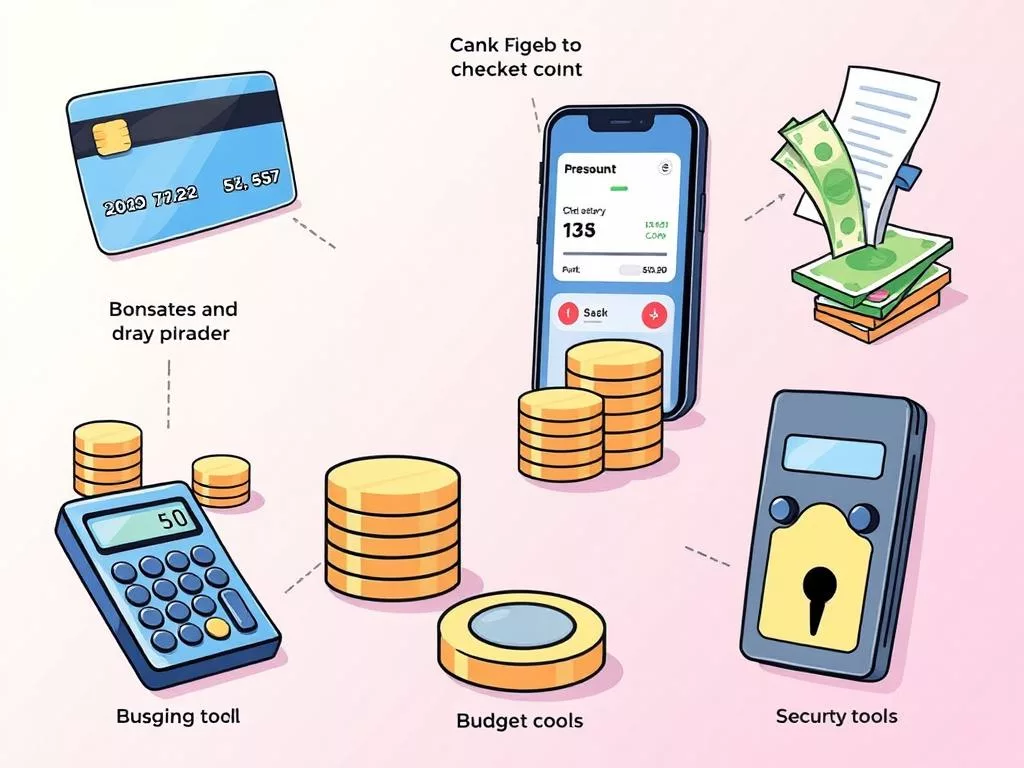Finding the right checking account is key to managing your money. This guide will help you understand different account features. It’s important to know how checking accounts compare to savings accounts.
When looking for a checking account, do your homework. Banks often require ID, birthdate, Social Security number, and contact info. Some accounts may have fees that affect your daily spending.
We’ll show you how to pick an account that fits your financial style. We’ll compare traditional checking accounts with prepaid debit cards and cash management accounts. This will help you make a smart choice.
Understanding Checking Accounts
Checking accounts are key financial tools for managing daily expenses. They offer a simple way to handle transactions like bill payments and purchases. Most banks provide checking accounts for easy access to cash.
Checking accounts come with useful features. You can make unlimited deposits and withdrawals. They also support direct debit and come with debit cards for easy access. Even though they might not earn as much interest as savings accounts, they’re great for everyday use.
There are many types of checking accounts to fit different needs. Here are some common ones:
- Free checking accounts: These have no monthly fees, making them a favorite choice.
- Interest-bearing checking accounts: You can earn interest on your deposits, helping your money grow.
- Premium checking accounts: They offer more benefits, like higher interest rates, for those with bigger balances.
- Joint checking accounts: Perfect for couples or partners to manage shared expenses together.
- Student checking accounts: Designed for young adults, they often have lower fees and no minimum balance.
The benefits of checking accounts include making everyday transactions easy without high fees. Online checking accounts, for example, usually have no monthly fees and few requirements. Special accounts like second-chance accounts help people rebuild their banking history, but they might have some limits.
Choosing the right checking account depends on understanding your options. For more details, check out guides on checking accounts. Investopedia has a lot of useful information on this topic.
| Account Type | Monthly Fees | Interest Rates | Who It’s For |
|---|---|---|---|
| Traditional | Around $5 or less | Low or none | General public |
| Free Checking | $0 | No interest | Cost-conscious users |
| Interest-bearing | Varies | Higher than traditional | Those seeking interest |
| Joint Checking | Around $5 or less | Low or none | Couples and partners |
| Student Checking | Minimal or $0 | Low or none | Students aged 18-24 |
What to Look For in a Checking Account
Finding the right checking account can really improve your banking life. Important checking account features help find the best match for your money needs. It’s key to compare monthly fees. Some banks charge fees that add up fast.
Interest rates on checking accounts might not be as high as savings or money market rates. But, it’s worth checking them out. Knowing about overdraft policies is also important. Many accounts offer protection but might charge for each use.
Look for banking services with great digital tools. Features like mobile apps, online bill pay, and security are must-haves for easy banking. Good customer support can also make a big difference.
Choose accounts with good policies, like ATM fee refunds and low balance requirements for fee waivers. This way, you save money and get more services. Many people prefer accounts that fit their spending and financial needs well.

For more info on top choices, check out this guide. It offers comparisons and insights into current deals.
Guide to Which Type of Bank Account is Best for Everyday Transactions
Choosing the right bank account is key for managing your money well. There are many daily banking options to fit your needs. Knowing the differences helps you pick the best account for you.
Checking accounts come in many forms, like free checking and interest-bearing accounts. But, they often have fees. These can include monthly fees, overdraft fees, and NSF fees. It’s important to look at these costs to find an account that saves you money.
High-yield savings accounts offer great interest rates but need a bigger deposit. Money market accounts also have good rates and let you write a few checks a month. But, they require a lot of money in your account. For the best rates, consider certificates of deposit (CDs). They have high rates but charge penalties if you take your money out early.
To show the differences, here’s a table of key features for each account type:
| Account Type | Average APY | Monthly Fees | Minimum Deposit | Withdrawal Limits |
|---|---|---|---|---|
| Traditional Checking | 0.01% | $5+ | $25 | Unlimited |
| High-Yield Savings | 4.00% – 4.35% | $0 | $1,000 | 6 per month |
| Money Market Account | 3.60% – 4.00% | $0 – $12 | $1,000 | Limited checks per month |
| Certificate of Deposit (CD) | 4.00% – 4.65% | $0 | $1,000 | None until maturity |

Everyone’s financial needs are different. It’s important to think about fees, interest rates, and how easy it is to use. Mixing different accounts can make banking better and increase your returns. Making a smart choice can really help your financial health.
Managing Your Checking Account Effectively
Managing your checking account well is key to keeping your finances in check. It helps avoid extra fees. Checking your balance often can prevent overdrafts and stick to your budget.
Many people check their balances a few times a week. They use apps, text alerts, or call customer service. This helps track spending and boosts financial awareness.
Automating your banking is another smart move. Direct deposits and automated bill payments save time and avoid late fees. Some banks even waive fees if you meet certain conditions, like keeping a minimum balance.
Using features like identity protection and cash-back rewards can make banking better. Combining accounts and using these services simplifies money management. It helps track spending and reach financial goals.
Knowing how banks handle fees and rules is important. It leads to smarter banking habits. This way, you can stay on top of your finances.

